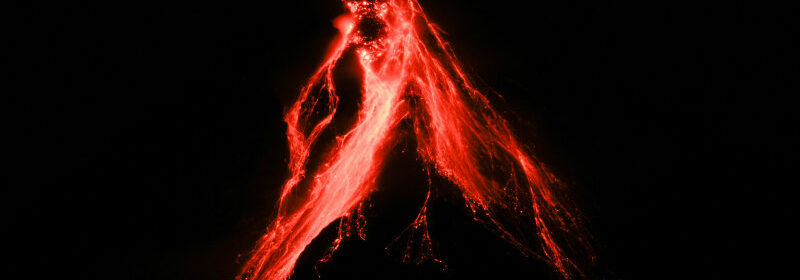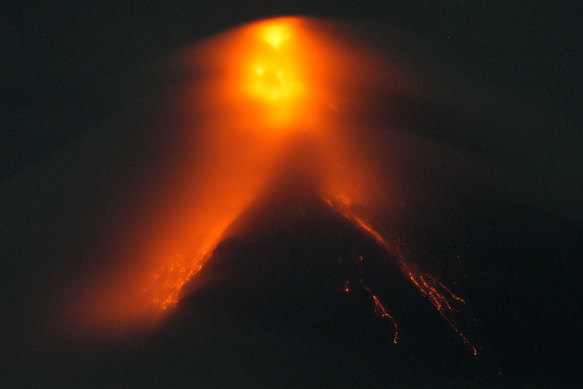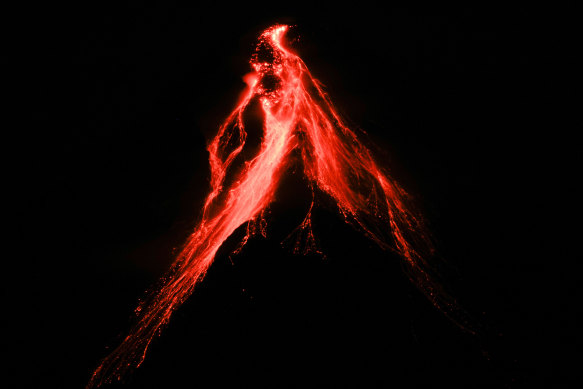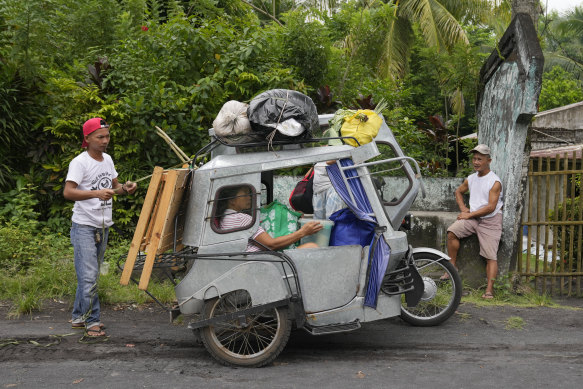Risk of eruption forces evacuations as Philippines’ most active volcano rumbles

Save articles for later
Add articles to your saved list and come back to them any time.
Daraga, Philippines: The Philippines’ most active volcano has begun spewing lava in a gentle eruption, putting thousands of people on heightened alert for the possibility of a violent explosion that would force them to suddenly evacuate from their homes, authorities said on Monday.
More than 12,000 villagers have left their homes so far in mandatory evacuations from the mostly poor farming communities within a 6 kilometre radius of Mayon volcano’s crater in north-eastern Albay province. Those evacuations began after the volcano stated showing signs of renewed restlessness last week.
Mayon volcano belches red-hot emissions down its slope as seen from Legaspi, Albay province, north-eastern Philippines on Sunday.Credit: AP
Authorities cautioned that thousands more remain within the permanent danger zone below Mayon, which has long been declared off-limits.
With the volcano beginning to expel lava on Sunday night, the high-risk zone around Mayon may be expanded should the eruption turn violent, said Teresito Bacolcol, director of the Philippine Institute of Volcanology and Seismology. Bacolcol said if that happens, people in any expanded danger zone should be prepared to evacuate to emergency shelters.
From a distance on Sunday night, a team of Associated Press journalists witnessed the volcano spewing lava down its south-eastern gullies for hours. People hurriedly stepped out of restaurants and bars in a seaside district of Albay’s capital city of Legazpi, about 14 kilometres from Mayon, many snapping pictures of the country’s most popular volcano.
Albay was placed under a state of emergency on Friday to allow for quicker distribution of any disaster relief funds in the event of a major eruption. On Thursday, authorities raised the alert level for the 2462-metre volcano.
Mayon volcano, pictured on Sunday, last erupted in 2018.Credit: AP
A key tourist draw for its picturesque conical shape, Mayon is one of the country’s 24 active volcanoes. It last erupted violently in 2018, displacing tens of thousands of villagers.
In 1814, Mayon’s eruption buried entire villages and reportedly left more than 1000 people dead. But many of Albay’s people have accepted the volcano’s sporadic fury as part of their lives.
Aside from villagers living in communities perilously close to the volcano, authorities and villagers began moving large numbers of cows and water buffaloes on Sunday from high-risk farms to 25 temporary grazing areas a safe distance away. They’re following more than 12,600 villagers who have moved to emergency shelters since last week, when Mayon began spewing superheated gas and producing heavy ashfall in a sign of a possible major eruption imminent within days or weeks.
Residents living near the Mayon volcano prepare to move to an evacuation centre on Sunday.Credit: AP
“It’s not only people that should be brought to safety but their farm animals too,” Albay provincial veterinarian Manny Victorino said. He said authorities were taking steps to avoid a deeper economic impact should the volcano erupt.
In Matnog village in Daraga town, Victorino and his team of veterinarians provided deworming medicine, injected vitamin supplements and punched identifying tags onto the ears of several cows and buffaloes for better monitoring.
The cattle evacuations underscore the government’s dilemma in dealing with threats from about two dozen active volcanoes, led by Mayon, spread across the sprawling archipelago. Located in the so-called Pacific “Ring of Fire,” a region prone to earthquakes and volcanic eruptions, the Philippines is also lashed by about 20 typhoons and storms a year, making the Southeast Asian nation one of the world’s most disaster-prone.
On Sunday morning, throngs of people jogged or biked, joined a group dancing to disco music and walked their dogs in a seaside promenade in Legazpi. The volcano lay hidden in thick clouds at a distance.
A resident, Violeto Peralta, caught the attention of passersby, painting an image of Mayon’s explosive eruption on the concrete fence of his roadside house. Passing schoolchildren, he said, would be happy to use his painting as a backdrop for their selfies.
He said that many businesses in the province have grown rich from diverse tourist activities that have sprung from Mayon, including sightseeing tours around the country’s most active volcano.
“We’re not scared of it,” the 76-year-old said. “We’ve learned to live with it.”
AP
Most Viewed in World
From our partners
Source: Read Full Article


